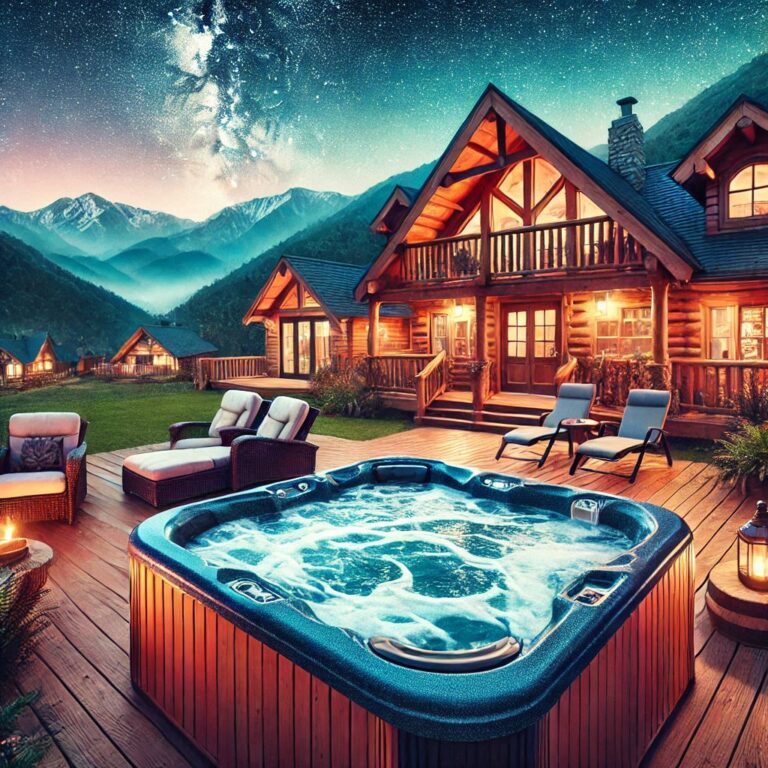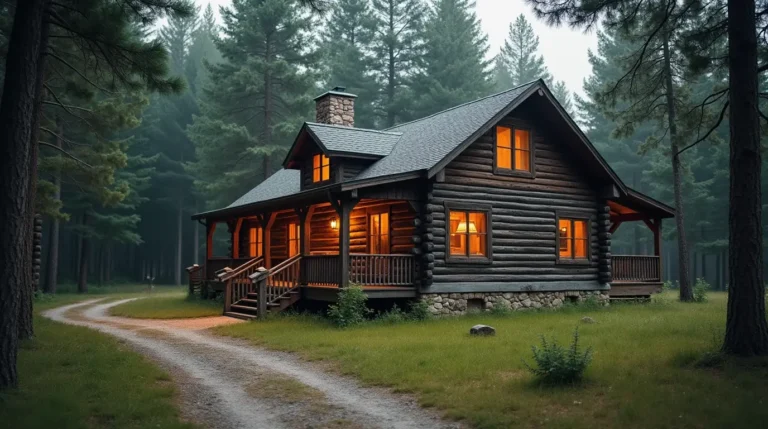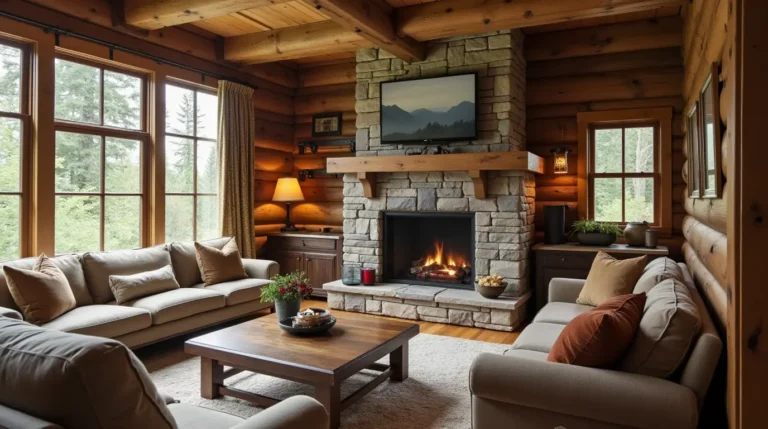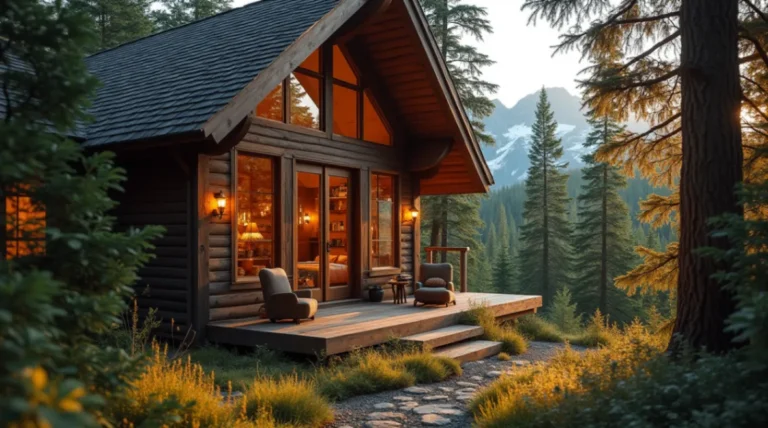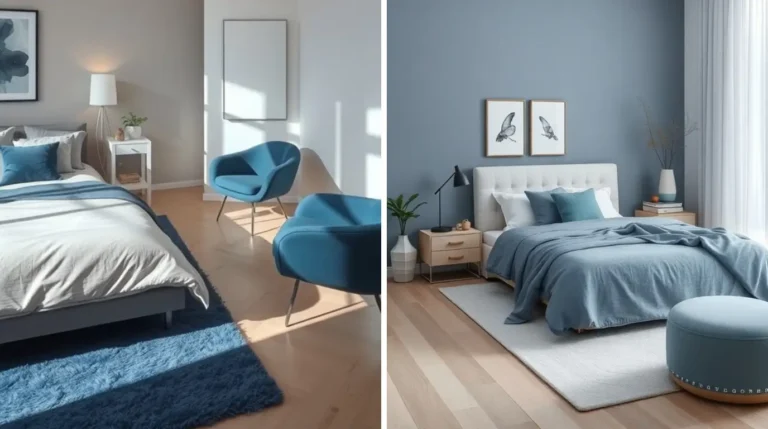Log cabin exterior: How to create a cozy rustic look
Creating a cozy rustic look for your log cabin is key to blending it with nature. It makes your home inviting and warm. A well-designed log cabin exterior boosts both beauty and property value.

To get an authentic and inviting log cabin design, focus on the elements that bring rustic charm. Choose the right materials, colors, and architectural features. These should match the natural environment.
Key Takeaways
- Understand the importance of a well-designed log cabin exterior.
- Learn how to choose materials and colors that complement the natural surroundings.
- Discover architectural features that enhance the rustic charm.
- Explore tips on how to increase your property’s value with a cozy log cabin design.
- Find out how to achieve an authentic and inviting log cabin exterior.
The enduring appeal of rustic log homes
Log cabins have a special charm that brings back memories and connects us to nature. This charm comes from their history, modern updates, and the good feelings they give us.
Historical Significance of Log Cabin Architecture
Log cabins have been homes for many cultures for centuries. They use natural wood, showing our connection to the earth. These cabins represent a simpler, more traditional life.
Modern Interpretations of the Classic Log Cabin
Today’s log cabins mix old charm with new comforts. They use modern materials and methods for better energy use and lasting quality. This mix lets people enjoy the rustic feel with today’s comforts.
Psychological Benefits of Rustic Aesthetics
Log cabins offer many mental health benefits, like less stress and better mood. Their natural look and feel make a place feel cozy and inviting. Studies show being around nature can make us feel better, adding to log cabins’ charm.
| Aspect | Traditional Log Cabins | Modern Log Cabins |
|---|---|---|
| Materials | Natural wood, often hand-hewn | Combination of traditional wood and modern materials for insulation and durability |
| Design | Simple, functional designs | Incorporates modern architectural elements while maintaining rustic charm |
| Energy Efficiency | Limited by traditional construction methods | Enhanced with modern insulation techniques and materials |

Planning your log cabin exterior project
Before starting your log cabin renovation, it’s key to plan well. A good plan keeps the rustic charm and makes the structure last longer.

Assessing your current exterior condition
Start by checking your log cabin’s exterior. Look for cracks, rot, or pest damage. This tells you where to focus first and what can wait.
Setting realistic goals and budgets
After checking the condition, decide what you want to achieve. You might want to improve looks or strengthen the structure. It’s also important to set a budget. Think about material costs, labor, and any surprises.
For upkeep, include costs for staining, sealing, and inspections. This keeps damage away in the future.
Creating a seasonal project timeline
Make a timeline that considers the seasons. Tasks like staining or sealing need good weather. Plan your work for the best times of the year.
By following these steps, your log cabin project will be well-planned. It will stay within budget and finish on time.
Essential materials for authentic log cabin exteriors
To create a real log cabin look, you need to pick the right materials. These should add to the cabin’s rustic charm and last long. The right choices can greatly improve how the cabin looks and lasts.
Types of Wood Species and Their Characteristics
The wood you choose for the outside of a log cabin is key. It affects how the cabin looks and how well it lasts. Different woods bring unique qualities that can make the cabin look more rustic.
- Pine is a favorite because it’s easy to find and not too expensive. It’s light in color and has a straight grain, fitting many cabin styles well.
- Cedar stands out for fighting off rot, decay, and bugs. It smells great and looks rustic.
- Oak is strong and lasts a long time. Its grain pattern adds to the cabin’s rustic charm.
Pine, Cedar, and Oak Comparisons
When looking at pine, cedar, and oak, think about cost, how long they last, and upkeep. Cedar and oak are tougher and bug-resistant, but pine is cheaper.
Reclaimed Wood Options
Reclaimed wood is great for cabin exteriors. It gives a weathered look that adds character. It comes from old buildings, barns, or trees, saving resources and history.

Alternative Siding Options for Cabin-Inspired Looks
If you don’t want traditional log siding, there are other options. These can give a cabin look without the usual wood. Options include:
- Wood-look vinyl siding
- Engineered wood siding
- Log-look metal siding
These alternatives are easier to care for and last longer than real wood siding.
Selecting Quality Finishes and Preservatives
Choosing good finishes and preservatives is key, no matter the siding. They protect the exterior from the weather. Stains, sealants, and coatings enhance the wood’s look and guard against moisture and UV rays.
| Finish Type | Benefits | Considerations |
|---|---|---|
| Stains | Enhance color, UV protection | May require frequent reapplication |
| Sealants | Moisture protection, durability | It may require frequent reapplication |
| Protective Coatings | Long-lasting protection, easy maintenance | Higher upfront cost |
Preparing your log cabin exterior for renovation
Before starting your log cabin exterior renovation, prepare the surface well. This step is key for a good look and strong structure. A clean surface means a better finish and longer-lasting work.
Deep cleaning techniques for log surfaces
Start by deep cleaning your log cabin exterior. Use a soft-bristle brush or a low-pressure washer to get rid of dirt. Don’t use high-pressure washers, as they can harm the wood. For hard stains, mix water with a mild detergent. Rinse well to avoid soap problems with the new finish.

Removing old finishes and addressing damage
After cleaning, check for old finishes to remove. Use a chemical stripper that fits your log cabin’s wood. Follow the stripper’s instructions, then scrape off the old finish. Fix any log damage, like cracks or rot, with wood filler. Let it dry before you continue.
Inspecting for structural issues before cosmetic work
Before cosmetic work, check for structural problems. Look for wood rot, termite damage, or weak spots. Also, check the chinking between logs and the roof. Fixing these issues now keeps your cabin safe and looking good.
By following these steps, you’re ready to renovate your log cabin exterior. You’ll get a beautiful and lasting result.
Log cabin exterior maintenance fundamentals
Keeping your log cabin’s exterior in top shape enhances its rustic charm and protects it from harsh weather. Regular upkeep is essential to keep your cabin looking great and lasting longer.
Effective maintenance covers several key areas. It’s important to spot and fix problems early to maintain your cabin’s structure and beauty.
Identifying and Preventing Wood Rot
Wood rot is a big problem for log cabins, caused by fungi that love damp places. To stop wood rot, keep the logs dry and ensure good airflow around the cabin.
Regular checks can catch signs of wood rot, such as softening or color changes early. Fixing these issues quickly can stop rot from spreading and save you money on repairs.
- Inspect logs for signs of moisture damage
- Ensure proper drainage around the cabin
- Keep logs clean and free of debris
Managing Moisture and Water Damage
Moisture is a major cause of damage to log cabins, leading to wood rot and weakening. Managing moisture well means keeping water away from the cabin.
Clear gutters, sloping ground, and proper flashing around windows and doors help. These steps direct water away from your cabin.
- Clean gutters regularly to prevent water accumulation
- Inspect and repair any damaged or missing flashing
- Ensure the ground around the cabin slopes away from the structure
Pest Prevention Strategies
Pests like termites and carpenter ants can seriously damage log cabins. To prevent infestations, remove attractants and seal entry points.
Regular checks and a clean cabin area can keep pests away. Applying pest-resistant treatments on logs also offers extra protection.
- Keep the area around the cabin free of debris and woodpiles
- Seal any cracks or gaps in the logs
- Use pest-resistant treatments on logs
Seasonal Maintenance Checklist
Regular upkeep is vital for your log cabin. A seasonal checklist helps you stay on track with important tasks.
Spring Maintenance Tasks
In spring, clean up winter debris, check for damage, and do any needed repairs.
- Inspect logs for winter damage
- Clean gutters and downspouts
- Check for signs of pest infestation
Fall Preparation for Winter
As fall comes, make sure your cabin is weather-tight and drainage systems are clear.
- Inspect and repair any gaps or cracks in the logs
- Clean and clear gutters and downspouts
- Ensure proper drainage around the cabin

Staining techniques for a perfect log cabin finish
A well-stained log cabin looks great and protects against the weather. The right staining techniques can greatly improve your cabin’s look and last longer.
Choosing the Right Stain Type for Your Climate
The right stain for your cabin depends on your local weather. In wet or rainy places, use a water-repellent stain to avoid damage. For sunny, dry areas, a UV-resistant stain keeps the wood from fading.
Stains come in oil-based and water-based types. Oil-based stains protect better against moisture but take longer to dry. Water-based stains are quicker to dry and easier to clean up.
Color Selection for Authentic Rustic Appeal
The stain color greatly affects your cabin’s rustic look. Popular colors include browns, tans, and grays, which match well with nature.
Think about the wood’s natural color and your surroundings when picking a stain. Always test the stain on a small area first.
Step-by-Step Staining Process
For a professional finish, follow a detailed staining process. Start by making sure the surface is clean and dry.
Application Tools and Techniques
Use good brushes or sprayers for your stain. Work in sections for even coverage. Always apply in the wood grain direction.
Drying and Curing Considerations
Let the stain dry as the maker says, usually 24 to 48 hours. Good airflow helps it dry faster.
| Stain Type | Drying Time | Recommended Application |
|---|---|---|
| Oil-Based | 48 hours | High humidity areas |
| Water-Based | 24 hours | Dry, sunny climates |
Maintenance Staining Schedule
Regular care keeps your cabin’s stain fresh. You’ll need to re-stain every 3 to 5 years, based on weather and exposure.
Check your cabin often to know when to re-stain. This keeps it protected and looking great.
Painting vs. staining: Making the right choice
The look of a log cabin’s exterior is important, but so is its protection. Choosing between painting and staining is key.
Both methods can make a log cabin look great and last longer. But, they have unique qualities that might fit your needs better.
Pros and cons of painted log cabins
Painting a log cabin gives it a strong, solid look. One big plus is that it guards against UV damage, which can harm wood.
But, paint can mask the wood’s natural texture, which many people love. Also, if not done right, paint can flake off, needing more upkeep.
When painting is preferable to staining
Painting is best if you want a certain color or if the logs are not perfect. It can hide flaws and give a consistent look.
Also, in harsh weather, paint might protect better than stains.
Techniques for painting log exteriors
To paint a log cabin well, start with a clean surface. This means scrubbing the logs and maybe using a primer.
Choose exterior paint made for log cabins. Follow the maker’s guide, usually two coats, for a lasting finish.
Weatherproofing your log cabin for longevity
Log cabins are charming but need regular weatherproofing to fight off the elements. This isn’t just upkeep; it’s an investment in your cabin’s long life and comfort. By keeping your cabin safe from harsh weather, you make it a cozy and secure place for years.
Sealing techniques for long-lasting protection
Sealing is key to protecting your log cabin. It adds a layer to keep moisture and UV rays out. Use high-quality sealants made for log cabins, following the maker’s guide. Clean the logs first and remove the old sealant before applying.
Check the logs for gaps or cracks where moisture can get in. Seal these spots with the right material to better protect your cabin.
Chinking and caulking for energy efficiency
Chinking and caulking keep your log cabin warm and dry. Chinking fills gaps between logs, while caulking is applying this material. Today’s chinking is flexible and lasts long, even with temperature changes.
Good chinking and caulking cut down on heat loss and keep moisture out. This means lower heating bills and a cozier cabin.
Modern weatherproofing products for log homes
There are many modern weatherproofing products for log homes. These include sealants, stains, and coatings that protect and beautify your cabin. When picking a product, look at its durability, UV protection, and log-type compatibility.
Some products also fight mold and mildew, making your cabin last longer and need less upkeep.
Creating the cozy rustic look for your log cabin exterior
A log cabin’s exterior is more than walls. It’s about creating a warm, inviting space that feels connected to nature. To achieve this, it’s important to know what makes a cozy rustic look.
Authentic Design Elements that Enhance Rustic Appeal
Authentic design elements are key to a log cabin’s rustic charm. They add character and warmth, making the cabin feel cozy.
Handcrafted Details and Accents
Wooden accents, hand-forged hardware, and custom trim work boost a log cabin’s rustic charm. These details make the cabin feel unique and inviting.
Natural Stone Features
Adding natural stone features like stone chimneys or pathways adds depth and texture. It helps the cabin blend in with its surroundings.
Color Schemes That Evoke Warmth and Coziness
The color scheme of a log cabin’s exterior is vital. Earthy tones like browns, tans, and greens create a cozy, rustic feel.
Balancing Rustic Charm with Modern Functionality
It’s important to keep the rustic charm while adding modern comforts. This ensures the cabin is both cozy and functional.
Regional Rustic Styles and Influences
Each region has its own rustic style, shaped by local materials and culture. Understanding these influences helps create a cabin that feels authentic and relevant.
By focusing on authentic design, color schemes, and regional styles, and balancing rustic charm with modern needs, homeowners can create a log cabin exterior that’s both cozy and welcoming.
Architectural enhancements for log cabin exteriors
A log cabin’s exterior is more than just a look. It’s a chance to mix function with rustic beauty. These upgrades can really boost the cabin’s look and value.
Porch and Deck Designs that Complement Log Structures
Porches and decks extend the cabin’s space, merging indoors with outdoors. It’s key to pick materials and styles that match the cabin’s rustic vibe. For example, using natural wood for decks and porches can make the cabin and its surroundings feel connected.
Wrap-around porches are a hit for log cabins. They offer wide views of the landscape. The design should fit the cabin’s style, making sure the porch or deck doesn’t overshadow it but rather highlights its beauty.
Window and Door Trim Considerations
The trim around windows and doors greatly affects a log cabin’s look. Picking trim that matches or complements the logs creates a unified appearance. The trim’s style can also add a modern twist or keep the rustic feel.
Using reclaimed wood for trim adds to the cabin’s rustic charm. It also gives the exterior a unique character.
| Trim Style | Description | Rustic Appeal |
|---|---|---|
| Simple Trim | Minimalist design that doesn’t distract from the log structure | High |
| Ornate Trim | Detailed designs that add a touch of elegance | Medium |
| Reclaimed Wood Trim | Trim made from reclaimed wood, adding authenticity | Very High |
Roof Styles and Materials for Rustic Appeal
The roof of a log cabin is key to its design. The roofing material and style greatly impact the cabin’s rustic charm.
Metal Roofing Options
Metal roofing is a top pick for log cabins. It’s durable and can handle tough weather. It can be styled to look like traditional materials or have a modern look.
Traditional Shake and Shingle Roofs
Shake and shingle roofs give a classic, rustic look that fits log cabins well. These materials can be treated to last longer and resist weathering.
Landscaping to complement your rustic log cabin
A well-designed landscape can make your log cabin look even better. It connects the cabin to nature, making it a perfect place to relax. Good landscaping also makes your cabin look more appealing and natural.
Plant selections that enhance woodland aesthetics
It’s important to pick the right plants for your log cabin. Choose native plants and trees like ferns, azaleas, and pine trees. They fit well with the woodland look and need less care, making your landscape inviting.
Creating natural pathways and borders
Paths and borders help visitors move around your landscape. Use stone, wood chips, or gravel for paths that look natural. For borders, try plants, stones, or wooden fencing to add structure and interest.
Outdoor lighting for a cozy cabin ambiance
Outdoor lights make your log cabin welcoming at night. Use solar lights, lanterns, and string lights for a cozy feel. Place lights on paths and around the cabin to highlight its beauty and warmth.
Seasonal decorative elements
Seasonal decorations keep your log cabin looking great all year. Add flowers, wreaths, and holiday lights. These touches add personality and warmth to your cabin’s exterior.
| Season | Decorative Elements | Tips |
|---|---|---|
| Spring | Plant flowers, greenery | Choose plants that bloom in spring |
| Summer | Outdoor furniture, lanterns | Use warm-toned lighting |
| Autumn | Pumpkins, fall leaves | Complement with autumn colors |
| Winter | Festive lights, wreaths | Use LED lights for energy efficiency |
Log cabin exterior restoration for historic homes
Restoring a historic log cabin is a delicate task. It’s about keeping its old charm while adding modern comforts. This balance is key to making the cabin both historic and functional today.
Evaluating Historic Log Structures
The first step in restoring a log cabin is to check its condition. Experts look at the cabin’s structure, find damage, and see how it was built. They use special tools to examine the logs and the cabin’s overall state.
| Assessment Criteria | Description | Importance Level |
|---|---|---|
| Structural Integrity | Evaluation of the cabin’s foundation, walls, and roof | High |
| Material Condition | Assessment of log condition, checking for rot, insect damage, etc. | High |
| Original Construction Techniques | Understanding the methods used to build the cabin originally | Medium |
Authentic Restoration Techniques
Using authentic methods is crucial for a log cabin’s restoration. This means choosing traditional materials and techniques, like hand-hewn logs and natural finishes. Modern materials and methods are okay, but they should blend in as much as possible.
Balancing Preservation with Modern Needs
One big challenge in restoring a log cabin is mixing old charm with new needs. This might mean adding modern insulation, electrical, and plumbing without losing the cabin’s historic look. It takes careful planning and execution to get this right.
Conclusion: Enjoying your cozy rustic log cabin exterior
Building a cozy rustic log cabin exterior is a fulfilling project. It mixes natural beauty with practical living. By following the steps in this article, you can make a warm and inviting log cabin design. This design will improve your outdoor living experience.
Choosing the right materials for your log cabin’s exterior is key. So is applying the perfect stain or paint. Every detail adds to your home’s look and lasts longer. Regular upkeep, like weatherproofing and checks, keeps your cabin cozy for years.
When you’re in your log cabin, think about adding landscaping and architectural touches. These can enhance its rustic charm. A well-designed log cabin exterior creates a peaceful and welcoming space. It connects you with nature.
With the knowledge from this article, you can fully enjoy your log cabin’s beauty. It becomes a perfect place for relaxation and fun.
FAQ
What is the best wood species for a log cabin exterior?
The best wood for a log cabin exterior depends on several things. These include how durable it is, how well it resists rot and insects, and how it looks. Pine, cedar, and oak are popular choices. Cedar is especially good because it naturally fights off decay and insects.
How often should I stain or paint my log cabin exterior?
How often to stain or paint your log cabin depends on a few things. These include the type of finish, the weather, and the wood’s condition. Staining is usually needed every 3-7 years. Painting might need to be done every 7-10 years. Checking your cabin regularly helps figure out the best time to do maintenance.
What is the difference between chinking and caulking in log cabin maintenance?
Chinking and caulking both seal gaps in log cabins, but they’re used for different sizes. Chinking fills bigger gaps between logs. Caulking is for smaller gaps. Both help keep your cabin energy-efficient and prevent water damage.
How can I prevent wood rot on my log cabin exterior?
To stop wood rot, make sure there’s good airflow around your cabin. Keep the outside clean and free of debris. Also, use a protective finish. Regular checks for rot or damage and quick repairs are key.
Can I paint over the stained log cabin exterior?
Yes, you can paint over the stained log cabin exterior, but you must prepare it first. Clean the surface, remove any loose stains, and apply primer if needed. Choosing the right paint is also important for lasting results.
What are the benefits of using reclaimed wood for log cabin siding?
Reclaimed wood adds character and history to your cabin. It’s also good for the environment because it reuses old materials. But, it might need extra prep and treatment for outdoor use.
How do I choose the right color scheme for my log cabin exterior?
Pick a color scheme that fits the natural surroundings, your cabin’s style, and your taste. Earthy tones like browns, tans, and greens are popular. They blend well with nature and enhance the cabin’s rustic look.
What are some effective pest prevention strategies for log cabins?
To keep pests away, seal all entry points and keep the area around your cabin clean. Use finishes or treatments that resist pests. Regular checks for pests are also important.
How can I improve the energy efficiency of my log cabin?
To make your cabin more energy-efficient, seal gaps with chinking and caulking. Make sure it’s well-insulated. Use energy-saving windows and doors. Regular maintenance, like staining or painting, helps too.
What are the key considerations for restoring a historic log cabin exterior?
Restoring a historic cabin requires careful planning. You need to evaluate the structure, use authentic materials, and balance old charm with modern needs. Working with preservation experts is crucial for a successful and respectful restoration.


